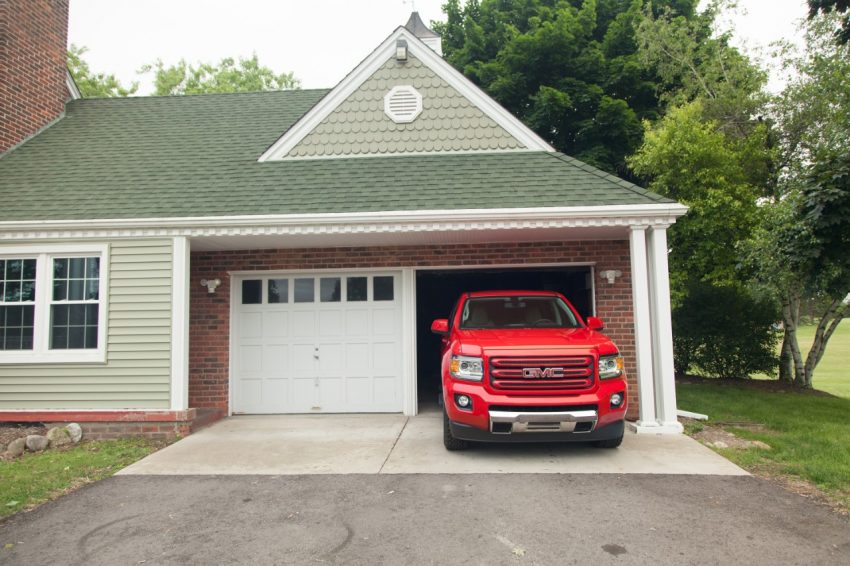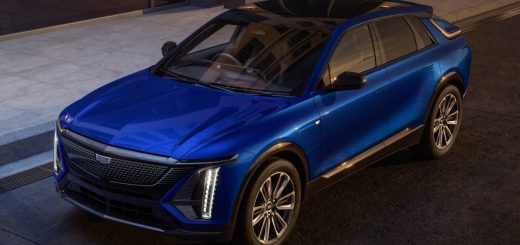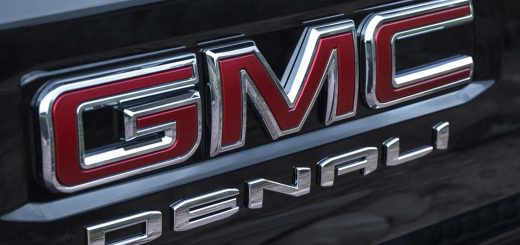General Motors has released official fuel economy figures for the all-new 2015 Chevrolet Colorado and GMC Canyon pickup trucks equipped with the 2.5-liter four cylinder LCV engine. GM says the trucks will offer both — class-leading fuel economy and payload ratings for midsize trucks powered with four cylinder engines when they go on sale later this fall.
Both the Colorado and Canyon equipped with the 2.5-liter engine, 2WD, and the available 6-speed automatic transmission will deliver an EPA-estimated 20 mpg in the city and 27 mpg on the highway for a combined 22 mpg rating. Trucks with the 2.5-liter I4 and 4WD will return an estimated 19 mpg in the city and 25 mpg highway for a combined rating of 21 mpg.
“Offering segment-leading four-cylinder fuel economy is yet another item to add to the Chevrolet Colorado’s long list of segment leads,” Colorado marketing manager Tony Johnson said in a statement. “It shows once again how the midsize segment can benefit from a fresh competitor offering the latest technologies.”
GM previously announced fuel economy figures for the Colorado and Canyon powered by the 3.6-liter V6 LFX engine. To note, Colorados and Canyons equipped with the 305 horsepower 3.6-liter V6, 2WD, and six-speed automatic transmission will return 18 mpg city and 26 mpg highway for a combined rating of 21 mpg. 4WD V6 trucks will deliver 24 mpg highway and 17 city for a combined rating of 20 mpg.
GM also confirmed payload ratings for V6 Colorados and Canyons: max payload ratings come in at 1,590 pounds and 1,620 pounds, respectively. The automaker says the small difference is due to differences in curb weight. The Canyon has alloy wheels as standard, whereas the Colorado uses heavier steel wheels.
“Having segment-leading V6 and four-cylinder efficiency, plus the highest payload rating, proves GMC has applied the latest technologies in just the right places, and our customers reap the benefits,” said Kenn Bakowski, marketing manager for the Canyon.
The two midsize pickups will be also be available with GM’s inline-four, 2.8-liter Duramax diesel engine from the 2016 model year. GM says it will release technical details and EPA fuel economy estimates for the engine closer to its launch sometime next year.















Comments
Considering the size of these trucks I think these numbers are pretty respectable. Guess it’s time we all come back to reality also. 🙂
I think they are larger than some who haven’t seen them in real life believe.
The 8 speeds and the diesel can’t come soon enough. Although these numbers for both the I4 and V6 are best in segment, they are not at all stellar. The I4 only getting 1 mpg better than the V6 makes for a lousy business case of down optioning to the I4. Why even offer the I4 if it doesn’t beat the V6 by at least 4 mpg on the highway. This just makes no sense. All I know is for the premium a customer will have to pay for the diesel, it better achieve a EPA-combined of 27 or 28 to make any sense whatsoever. Furthermore they did not mention the ratings for the manual. Do they just not care because most people will not get one?
I was so excited for this truck to hit the dealer lots, now I’m waiting to see what will be improved for 2016. If the transmissions, colors, and diesel don’t improve the Colorado in 2016, then I’ll be one of the customers to stick with a Silverado and just appreciate all the things it can do better than the Colorado while sucking down more go juice, but not much more. I am in need of a new truck as mine is pretty worn out. Instead of keeping me excited and ready to hit the lot as soon as the Colorado hit the market, I’m on the sidelines waiting again for a smaller truck. Maybe the Silverado will happen sooner when the deals come out next month along with the F150. Sorry Colorado.
The four cylinder should be significantly lower in price than a V6 variant which should make a difference in the marketplace.
I concur. While these numbers are class-leading, they’re somewhat disappointing. I was really hoping the smaller trucks would deliver that much-coveted 30 mpg fuel rating, especially with the 4-cylinder. While these numbers are good, they don’t offer that much of an incentive to purchase one over a full-size pickup, which offer relatively close fuel numbers. Nevertheless I still find these trucks appealing.
Hopefully the introduction of the new 8-speed along with the diesel engine will deliver more.
I am impressed with these numbers. Keep in mind that these numbers will improve in time as they will get new auto transmissions soon. I am interested to see how a 2.5L 4×4 drives. It would be a great off roader cause of the efficiency/range in a small package.
I expected around thirty for the four cylinder and if so I would buy one, but now I think I’ll wait. The four cylinder gas mileage is not good enough for me.
Not sure if you are in Canada or the US. If Canada, don’t forget these numbers are based on US gallons (3.8L) whereas Canadian gallons are 4.5L. So 25 mpg for the 2.5L 4×4 in the US equates to 29.5 mpg in Canada. The 27 mpg for a 2.5L 2 wheel drive equates to 31.86 mpg Canadian.
I can’t wait for the trucks to arrive here in Northern Virginia either. However, when it comes to options for the Colorado, its going to be touchy. For instance, the sliding window in rear of trucks won’t be available until next year. Why, no one can say. GM guys still don’t get it.
I imagine this is the “optional” way to increase cost to consumers. Other wise, why would you put out a product with out all options on the table for people? I’d never leave home with out matching shoes….Just saying. Cart before horse.
So you would actually delay the launch of the entire model because the supplier is not ready with a sliding rear window, on which the take rate will be less than 1 in 10?
You m’am, are a marketing genius
Many people don’t realize the limitations suppliers put on vehicle releases and dealer ordering. In Canada, we couldn’t get a sunroof for most of the year on the full size 1500’s, bucket seat options were severely restricted on both LT and LTZ models 1500’s, and even the trailer brake controller was severely limited in availability. Add in the fact we were severely limited on the number of available 6.2L. All of these are simple things that people do want, but if a supplier can’t build enough of them for the demand, there will be limitations. It is a fine line for the suppliers too between how many they can produce under their current production capabilities before needing to spend millions to expand production and whether the extra production required would actually pay for that very expensive expansion.
When the ’15 F150 with the new 2.7L TTV6 (325hp,375ib.ft.) hits the market with ratings similar to this for a full size truck, then these trucks won’t seem like they have……”the latest technology”. Granted there is a market for the smaller truck, but GM did little more than simply pluck a couple existing car engines from their line-up, re-tune a bit and bolt’em up? The 2.8L Duramax sounds like it may be the right choice? Just have to wait until ’16 and of course, be ready to pay a big premium for it over these engines.
So what exactly do you think the 3.5L ecoboost engine is? It is a car engine that is turbo’d.
The 2.7L will have great fuel ratings and Ford is giving it massive tow ratings for that size of engine, but just like the ecoboost, the mpg will drop like a rock the second you get up to highway speeds with any type of load because the turbo’s will always be kicked in.
As a fleet manager for a GM dealership, I have spoken with many companies who have the 3.5L Ecoboosts in their trucks and have had a ton of issues with them because their work trucks are always putting that engine to work. Turbo’s have been cooking, injector issues, plus trucks stalling out when you kick them down to pass on the highway. Plus they say their real world driving mpg is nowhere near the ratings and less than the 5.3L’s from GM they run in their fleets (and that is the previous 5.3L, not the ecotec3). The ones who have tried the new 2014 5.3L Ecotec3 in their fleets are impressed by it. Better mileage than the ecoboost, fewer issues with the actual motor, and has enough hp/torque for what they need. A few of them have taken the 6.2L because they want the torque/hp and say they get the same mpg as the ecoboost but kill it in power/torque and are again very happy.
The new Ford 2.7L engine is a new design and not related to the 3.5L or any other Ford car or truck engine. It will probably suffer a significant loss in fuel economy just like the 3.5L does if you “run it hard”? But that’s the best part about it. If you choose to “run it hard” then you have a strong truck engine (the 375lb.ft. is SAE certified and comes on at 2500 rpm). If you choose to “stay off of it” you end up with fuel economy that (probably) exceeds any other gas powered truck, regardless of size. You get to decide. This engine will also have start/stop mode. Ultimately, all of this is still speculation as these engines and trucks are still not available, but on paper it looks like a game changer.
If you do not think this MPG is any good then get to the dealer when they arrive and see just how large these trucks are.
Also keep in mind that there is more to this plan than just what we have so far. The Half ton market will only get more expensive and more limited. You will not continue to see large discounts in the future.
I still expect a smaller truck too coming. It may be auto or CUV based but I expect something interesting may come along at some point.
Also keep in mind GM ratings on most vehicles will beat the MPG ratings. All of my present vehicles meet or beat the number no matter how hard they are driven.
Have seen truck at dealership. Good looking truck. Fuel efficiency not what I expected. Even with unleaded in my area at $2.88, I not buying solely based on fuel economy. This truck would have gotten 1 mpg more if GM had not built it so tall to make it look big.
During assembly does the 2015 LT4 engine block use torque plates for final honing ?